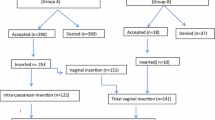Abstract
Objective
To assess the safety and efficacy of postpartum IUCD in caesarean section patients.
Methods
This prospective observational study included 200 women, who gave informed consent for postpartum intrauterine contraceptive device (PPIUCD) insertion during caesarean section from January 2013 to May 2014. These patients were followed up at 6 weeks and 6 months.
Results
There were no major complaints in either group in post-operative period. At 6-month follow-up in PPIUCD users, 89.5% of patients continued to use this method. 5.5% were lost to follow-up, 2.5% had spontaneous expulsion, and 2.5% removed the IUCD due to various reasons. Eight per cent of patients who wanted removal of IUCD in the second follow-up were counselled to continue, and they did so.
Conclusion
The results of our study suggest that immediate intra-caesarean IUCD insertion appears to be a safe and effective method of contraception. The acceptability of intra-caesarean IUCD was high, and its continuation rate has demonstrated its safety.


Similar content being viewed by others
References
Hanson JD, Nothwehr F, Yang JG, et al. Indirect and direct perceived behavioral control and the role of intention in the context of birth control behavior. Matern Child Health J. 2015;19(7):1535–42. https://doi.org/10.1007/s10995-014-1658-x.
Singh S, Shekhar C, Acharya R, et al. The incidence of abortion and unintended pregnancy in India, 2015. Lancet Glob Health. 2018;6(1):e111–20. https://doi.org/10.1016/S2214-109X(17)30453-9.
Henderson V, Stumbras K, Caskey R, et al. Understanding factors associated with postpartum visit attendance and contraception choices: listening to low-income postpartum women and health care providers. Matern Child Health J. 2016;20(Suppl 1):132–43.
Dr. Saswati Das, PPIUCD services in India: The journey from start to scale up, April 2013 https://www.k4health.org/sites/default/files/India%20Experience%20in%20PPIUCD_Presented%20at%20PPIUCD%20Zambia%20Mtg_April%202013.pdf
Singal S, Bharti R, Dewan R, et al. Clinical outcome of postplacental copper T 380 A insertion in women delivering by caesarean section. J Clin Diagn Res. Serial online 2014 09 (cited:2015 Jan 21) 9 O01.
WHO-Medical Eligibility Criteria WHO Library Cataloguing-in-Publication Data Medical eligibility criteria for contraceptive use—5th ed. Fifth edition 2015.
Gaikwad S, Gurran A. Int J Basic Appl Med Sci. 2014; 4(2), 195–197. ISSN: 2277-2103 (online) http://www.cibtech.org/jms.htm.
Afshan A, Asim SS. Immediate postpartum IUCD (PPIUCD): an opportunity not to be missed. ASH & KMDC. 2014;19(1):15.
Ruiz-velasco V, Garcia C, Castro H. Caesarean section IUD insertion. Contracept Deliv Syst. 1982;3(1):21–4.
Shukla M, Qureshi S, Chandrawati. Post placental intrauterine device insertion—A five year experience at a tertiary care centre in north India Deptt. of Obstetrics & Gyna. KG Medical University, Lucknow. Indian J Med Res. 2012;136(3):432–5.
Levi E, Cantillo E, Ades V, et al. Immediate postplacental IUCD insertion at caesarean delivery: a prospective cohort study contraception. 2012;86:102–5.
Celen S, Sucak A, Yildiz Y, et al. Immediate postplacental insertion of an intrauterine contraceptive device during caesarean section. Contraception. 2011;84(3):240–3.
Disclosure
There is no financial assistance from anywhere else except the supply of IUCD and gloves from government national programme.
Author information
Authors and Affiliations
Corresponding author
Ethics declarations
Conflict of interest
There is no conflict of interest.
Ethical Approval
Approval of the study was obtained from the ethical committee of the medical college.
Informed Consent
Informed written consent was received from all the participants.
Additional information
Publisher's Note
Springer Nature remains neutral with regard to jurisdictional claims in published maps and institutional affiliations.
Dr. Rekha Jakhar MBBS, MS (Gynecology & Obstetrics) is a Professor of Gynecology & Obstetrics in Dr. S. N. Medical College, Jodhpur. Ganesh Singhal MBBS is a Resident Gynecology & Obstetrics in Dr. S. N. Medical College, Jodhpur.
Rights and permissions
About this article
Cite this article
Jakhar, R., Singhal, G. Safety and Efficacy of Intra-caesarean IUCD: A Prospective Study at a Tertiary Care Centre. J Obstet Gynecol India 69, 325–329 (2019). https://doi.org/10.1007/s13224-019-01242-2
Received:
Accepted:
Published:
Issue Date:
DOI: https://doi.org/10.1007/s13224-019-01242-2




